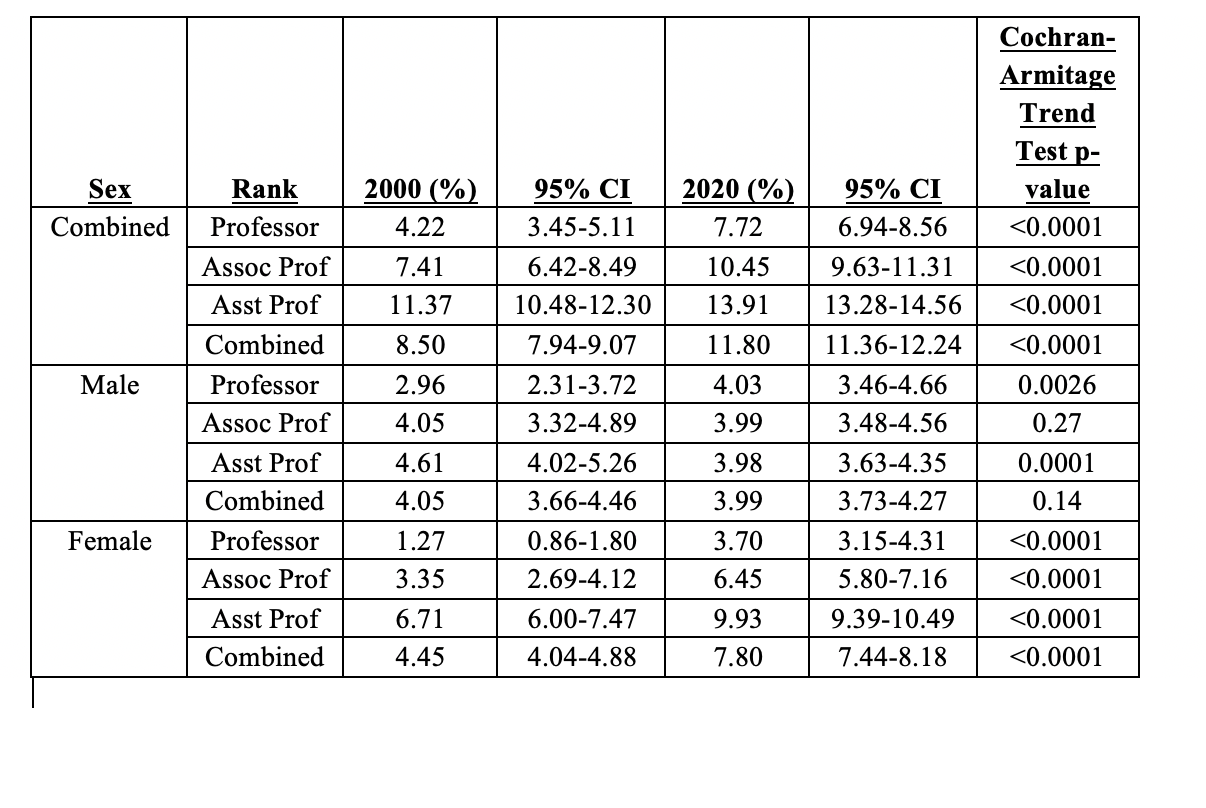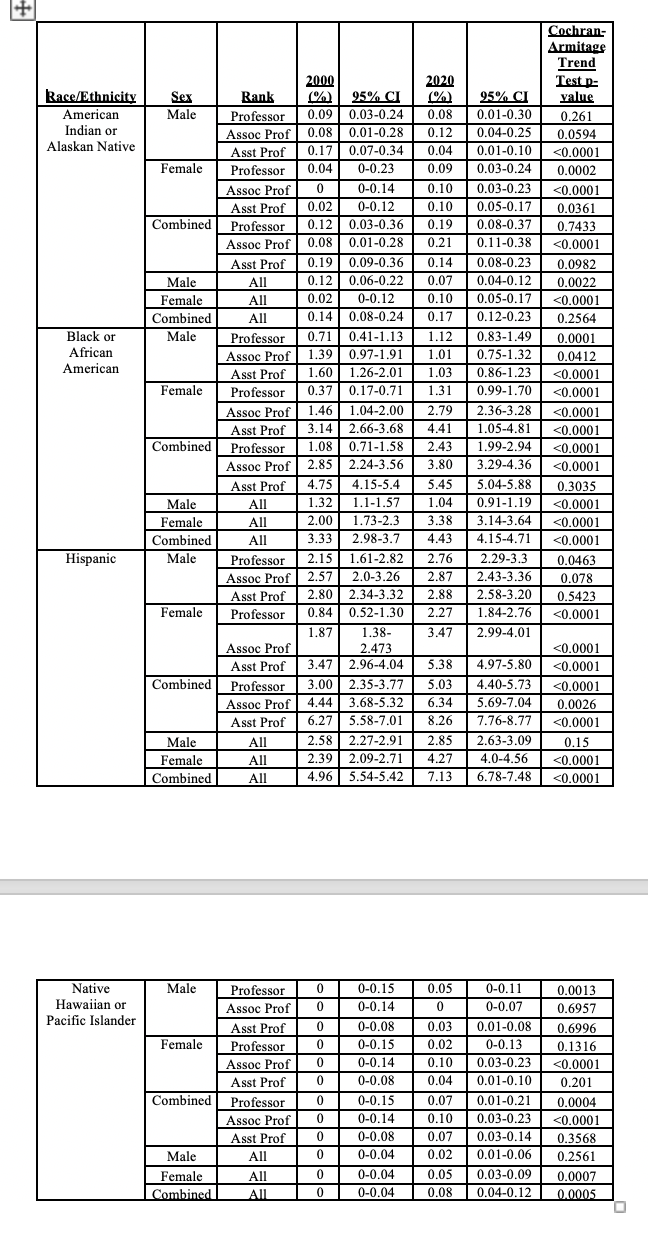Health Services Research
Category: Abstract Submission
Health Services Research II
211 - Trends in the Diversity of Pediatric Faculty, 2000-2020
Sunday, April 24, 2022
3:30 PM - 6:00 PM US MT
Poster Number: 211
Publication Number: 211.320
Publication Number: 211.320
Colin J. Orr, University of North Carolina, Chapel Hill, NC, United States; Emma A. Omoruyi, McGovern Medical School at the University of Texas Health Science Center at Houston, Houston, TX, United States; Gregory B. Russell, Wake Forest School of Medicine of Wake Forest Baptist Medical Center, Winston-Salem, NC, United States; Kimberly Montez, Wake Forest School of Medicine, Winston-Salem, NC, United States

Colin Orr, M.D.,M.P.H. (he/him/his)
Assistant Professor
University of North Carolina at Chapel Hill School of Medicine
Chapel Hill, North Carolina, United States
Presenting Author(s)
Background: Diversity and inclusion in academic medicine are important for addressing health disparities and training the next generation. Trends in pediatric faculty diversity have not been clearly illuminated.
Objective: Examine the trends in the diversity of pediatric faculty from 2000-2020
Design/Methods: Repeat cross-sectional study of sex, race, ethnicity, and rank of pediatric faculty using Association of American Medical Colleges (AAMC) Faculty Rosters from 2000-2020. The AAMC Medical Minority Applicant Registry defines underrepresented in medicine (URiM) as self-identification as African American/Black, Hispanic, American Indian/Alaska Native, or Native Hawaiian/Pacific Islander. Individuals identifying as non-Hispanic Asian, non-Hispanic White, non-Hispanic multiracial, and non-Hispanic other categories were included in the totals but not separately characterized. Trends in sex, race, ethnicity and rank were compared with the Cochran-Armitage test for all years. Data on self-reported race and ethnicity of faculty were compared to the general population over time using US Census Bureau data.
Results: A total of 367,863 pediatric faculty were included. Between the years 2000 and 2020, the total number of pediatric faculty increased from 9,510 to 17,033 . Trends in URiM faculty representation significantly increased at all ranks: professor (P < .0001), associate professor (P = .0001); and assistant professor (P = .0001). URiM male representation remained unchanged over time (P = 0.14), while significantly increased trends occurred in URiM female representation (P < .0001) (Table 1). African American/Black males significantly decreased representation at the associate (P = 0.04) and assistant professor levels (P < .0001), and American Indian/Alaska Native males significantly decreased representation at the assistant professor rank (P < .0001) (Table 2). Over time, the percentage of URiM pediatric faculty representation was considerably lower compared to representation in the US population.Conclusion(s): Gains have been made in the representation of individuals who identify as URiM among pediatric faculty; however, there is stagnation in the representation of individuals who identify as male and URiM in pediatric faculty. The diversity of pediatric faculty continues not to reflect the diversity of the US population which may have a critical impact on the field of pediatrics’ ability to recruit/retain a diverse workforce and promote equitable care. Efforts working at various points in the pipeline are needed to increase the diversity of pediatric faculty
Table 1: Trends in URiM Faculty by Sex and Rank, 2000-2020
Table 2: Trends in URiM Faculty by Race, Ethnicity and Sex, 2000-2020
Objective: Examine the trends in the diversity of pediatric faculty from 2000-2020
Design/Methods: Repeat cross-sectional study of sex, race, ethnicity, and rank of pediatric faculty using Association of American Medical Colleges (AAMC) Faculty Rosters from 2000-2020. The AAMC Medical Minority Applicant Registry defines underrepresented in medicine (URiM) as self-identification as African American/Black, Hispanic, American Indian/Alaska Native, or Native Hawaiian/Pacific Islander. Individuals identifying as non-Hispanic Asian, non-Hispanic White, non-Hispanic multiracial, and non-Hispanic other categories were included in the totals but not separately characterized. Trends in sex, race, ethnicity and rank were compared with the Cochran-Armitage test for all years. Data on self-reported race and ethnicity of faculty were compared to the general population over time using US Census Bureau data.
Results: A total of 367,863 pediatric faculty were included. Between the years 2000 and 2020, the total number of pediatric faculty increased from 9,510 to 17,033 . Trends in URiM faculty representation significantly increased at all ranks: professor (P < .0001), associate professor (P = .0001); and assistant professor (P = .0001). URiM male representation remained unchanged over time (P = 0.14), while significantly increased trends occurred in URiM female representation (P < .0001) (Table 1). African American/Black males significantly decreased representation at the associate (P = 0.04) and assistant professor levels (P < .0001), and American Indian/Alaska Native males significantly decreased representation at the assistant professor rank (P < .0001) (Table 2). Over time, the percentage of URiM pediatric faculty representation was considerably lower compared to representation in the US population.Conclusion(s): Gains have been made in the representation of individuals who identify as URiM among pediatric faculty; however, there is stagnation in the representation of individuals who identify as male and URiM in pediatric faculty. The diversity of pediatric faculty continues not to reflect the diversity of the US population which may have a critical impact on the field of pediatrics’ ability to recruit/retain a diverse workforce and promote equitable care. Efforts working at various points in the pipeline are needed to increase the diversity of pediatric faculty
Table 1: Trends in URiM Faculty by Sex and Rank, 2000-2020

Table 2: Trends in URiM Faculty by Race, Ethnicity and Sex, 2000-2020

